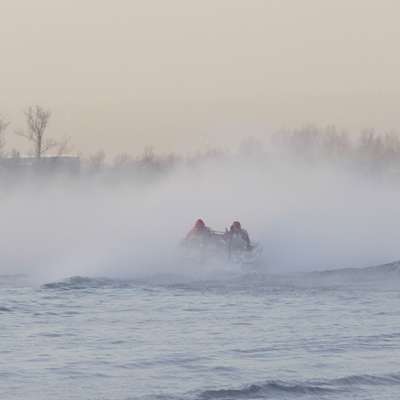
Bass rigs are expensive. Taking care of them is a matter of common sense. That same common sense tells us there's a right way to do it and a wrong way. This two-part series will look closely at the right way. Part I detailed procedures for maintaining the hull. Part II will do the same for the motor.
Part II: The Motor
Winterizing your motor depends mostly on how you use your boat. If you fish off and on during the winter months — fishing when it's warm, parking your rig when it's cold — you'll need to follow at least three simple procedures to protect it.
1. When you first start the motor in the water, allow it to warm up a bit before you leave the dock.
"It's important to run the motor a few minutes before you leave the dock. This allows the thermostat to open and begins the cooling process. If you don't do this, you run the risk of allowing the motor to overheat before the thermostat opens. Then, when it does open, cold water hits the hot motor parts. That can cause a lot of damage to the powerhead.
"Make sure there's warm water exiting the telltale port (pee hole) before you blast off," recommends Sam Plapp, a former marine service manager.
2. After fishing make sure you store the motor in a vertical position.
"Outboards have a positive drain system. The water will flow down and out of the motor if it's vertical. Don't store the boat with the motor resting on the transom brace. That'll trap water inside the motor. Some anglers wrap the lower unit with a plastic garbage bag to keep water from collecting in the exhaust cavity," he continues.
Do not run the motor dry to remove the water. It only takes a few seconds to overheat!
3. Mercury recommends that you keep the motor tilted down so that the gear case is in the water during cold weather operation. This prevents water trapped in the gear case from freezing and causing expensive damage to the motor.
For long-term storage the procedure is somewhat different and more complicated.
1. Store the boat motor vertical and make sure the water drains out of the motor. Cover the exhaust ports if necessary. (Reminder: Do not run it dry.)
2. Some motors require fogging or lubrication, but not all. And even those that do use different products and different procedures depending upon how fuel is delivered to the engine and how the motor is designed. Always, without exception, check the owner's manual for detailed recommendations on procedure and products before you fog or lubricate your motor. Doing it wrong can cause extensive damage.
3. Never leave the gear case empty. Always drain and refill it with the proper grease. An empty gear case will often collect moisture and water which can cause big problems — ice and rust related — over the course of the winter.
"We strongly recommend anglers have their winterization done by a professional. The cost is minimal — less than $150 in most shops — and the benefits are enormous. Not only will your motor be protected over the winter, but little problems the angler doesn't know about can be diagnosed and corrected before they become big problems," advises Plapp.
Originally published December 2008




